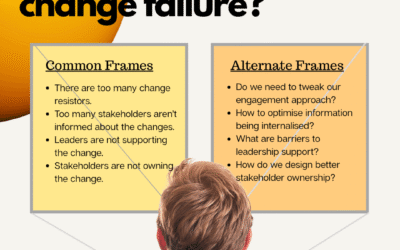When navigating the complexities of organizational change, leaders often rely on analogies to communicate the journey and keep their teams motivated. One common analogy is the “light at the end of the tunnel,” which portrays the change process as a long, dark journey with an illuminating endpoint. We explores why the “light at the end of the tunnel” analogy is inadequate, proposes a more accurate depiction, and provides practical tips for developing a clear vision and crafting a compelling narrative to guide your organization through change.
‘The light at the end of the tunnel’ is often used an analogy when describing the change journey. The tunnel describes the change journey, often dark with potential obstacles along the way. People may not know exactly what the end looks like and at times it may feel frustrating and challenging. Eventually, approaching the end of the journey, people start to see the light at the end of the tunnel. Excitement builds and people get more excited and relieved. The end.
The other key reason why people use this analogy is to stress how important to engage employees so that they are clear with what the end of the tunnel looks like. Being clear with what the end state looks like is critical to sustain momentum and energy to want to keep going along the change journey. The ability to ‘see’ the light at the end of the tunnel in your impacted stakeholders is a key indicator of eventual change success. However, this analogy falls short in capturing the dynamic and multifaceted nature of modern organizational transformations.
In reality, the path to successful change is more like a tunnel with intermittent windows of light, reflecting the multiple initiatives and milestones that punctuate the journey. By adopting this more nuanced analogy, leaders can better communicate the realities of change, maintain momentum, and foster sustained engagement across the organization.
The Shortcomings of the “Light at the End of the Tunnel” Analogy
Misleading Simplicity
The “light at the end of the tunnel” analogy suggests a linear, singular path with a single destination. It implies that the journey is uniformly dark and challenging until the very end, where a sudden and complete transformation occurs. This perspective can be misleading for several reasons:
- Oversimplification: Organizational change is rarely a single, straightforward journey. It involves multiple phases, each with its own challenges and victories. The analogy fails to account for the complexity and non-linear nature of most change processes.
- Unrealistic Expectations: By implying that the journey is mostly dark and only brightens at the end, this analogy can demoralize teams. It suggests that rewards and progress are only visible at the conclusion, which can lead to fatigue and disengagement.
- Neglect of Ongoing Progress: The analogy does not recognize the incremental achievements and intermittent successes that occur throughout the change process. These smaller victories are crucial for maintaining motivation and momentum.
Failing to Reflect Reality
In reality, organizational change involves multiple initiatives running concurrently, each with its own goals, challenges, and successes. These initiatives create a landscape that is far from uniformly dark; instead, it is punctuated with periods of light—moments of clarity, success, and learning.
When there are multiple initiatives the key then becomes to pain the overall picture of what the end of the tunnel looks like. This is not just what the end state of one initiative looks like. It is what the culmination of all the various changes look like. It is about articulating super clearly what it means to have reached particular milestones within the various strategies undertaken (of which the various changes are aimed to support).

A More Accurate Analogy: A Tunnel with Intermittent Windows of Light
Embracing the Multifaceted Nature of Change
A more fitting analogy for the change journey is a tunnel with intermittent windows of light. This analogy acknowledges the complexity and multifaceted nature of change. Here’s why it’s more appropriate:
- Multiple Initiatives: Organizations often undertake several change initiatives simultaneously. Each initiative represents a different window of light, providing opportunities for progress and insight along the way.
- Intermittent Successes: This analogy highlights the importance of recognizing and celebrating interim successes. These windows of light can rejuvenate the team’s spirit and provide evidence that the change is working.
- Continuous Learning: Intermittent light symbolizes moments of learning and adaptation. As the organization progresses, these windows provide valuable feedback, allowing for adjustments and improvements.
- Sustained Motivation: By acknowledging periodic achievements, this analogy helps sustain motivation. Teams can look forward to these windows of light, making the journey less daunting and more engaging.
Developing a Clear Picture of the End State
Importance of a Clear Vision
A clear and compelling vision is essential for guiding the organization through change. It provides a sense of direction and purpose, helping teams understand the ultimate goal and their role in achieving it. Here are practical steps to develop and communicate a clear picture of the end state:
- Define the Vision: Articulate a clear, concise, and inspiring vision that encapsulates the desired end state. This vision should align with the organization’s values and strategic objectives.
- Involve Stakeholders: Engage key stakeholders in the vision development process. Their input and buy-in are critical for ensuring that the vision is relevant and achievable.
- Visualize the Future: Create visual representations of the end state, such as diagrams, infographics, or mock-ups. These tools can help make the vision more tangible and relatable.
- Break Down the Vision: Decompose the vision into specific, measurable objectives and milestones. This makes the vision more manageable and provides clear targets for the team to aim for.
- Communicate Consistently: Regularly communicate the vision and progress towards it. Use multiple channels and formats to ensure that the message reaches all parts of the organization.

Crafting the Story for Your Audience
Tailoring the Narrative
Crafting a compelling story that resonates with different audiences within the organization is crucial for maintaining engagement and momentum. Here’s how to tailor the narrative effectively:
- Understand Your Audience: Different groups within the organization will have different concerns, priorities, and levels of influence. Tailor the narrative to address the specific needs and interests of each audience segment.
- Highlight Relevance: Explain how the change will impact each audience group. Highlight the benefits and address potential concerns to demonstrate relevance and importance.
- Use Relatable Examples: Use examples and stories that resonate with each audience group. Relatable narratives can make the vision more accessible and credible.
- Showcase Interim Wins: Regularly share stories of interim successes and milestones. These stories can serve as proof points that the change is progressing and having a positive impact.
- Leverage Champions: Identify and empower change champions within each audience group. These individuals can help amplify the narrative and foster a sense of ownership and commitment.
The story can be, and should be, articulated at different levels of the organisation. Senior leaders have a role to play to illustrate what business will look like and how the organisation will function differently. Departmental managers also have a role to play to spell out how the work of the department will change accordingly. Team leaders also need to play a part in deciphering what the changes will look like and how the work of the team will evolve in the future. The managerial skills required in doing this and to help employee join dots is critical and cannot be neglected.
Keeping the Momentum
Maintaining momentum throughout the change process requires continuous effort and strategic communication. Here are some tips to keep the energy and enthusiasm alive:
- Celebrate Milestones: Acknowledge and celebrate interim successes and milestones. This not only boosts morale but also reinforces the perception of progress.
- Provide Regular Updates: Keep the organization informed about the progress, challenges, and next steps. Transparency builds trust and keeps the team aligned.
- Encourage Feedback: Create channels for feedback and actively seek input from the team. This fosters a sense of involvement and helps identify areas for improvement.
- Adapt and Iterate: Be prepared to adapt the approach based on feedback and changing circumstances. Flexibility is key to navigating the complexities of change.
- Recognize Effort: Regularly recognize and reward the efforts and contributions of individuals and teams. Appreciation and recognition can significantly enhance motivation and engagement.
The “light at the end of the tunnel” analogy, while common, fails to capture the true nature of organizational change. A more accurate depiction is a tunnel with intermittent windows of light, reflecting the multiple initiatives, interim successes, and continuous learning that characterize the change journey. By adopting this more nuanced analogy, leaders can better communicate the realities of change, maintain momentum, and foster sustained engagement across the organization.
To navigate the complexities of change effectively, it is crucial to develop a clear vision of the end state and craft a compelling narrative tailored to different audiences. Regularly celebrating milestones, providing updates, encouraging feedback, and recognizing effort are all essential strategies for maintaining motivation and ensuring the successful implementation of change initiatives. By embracing these practices, organizations can not only survive the journey through the tunnel but thrive and emerge stronger on the other side.






